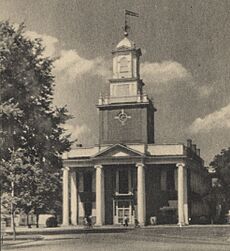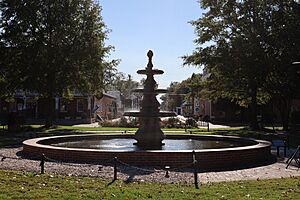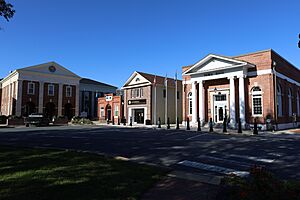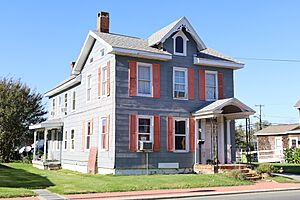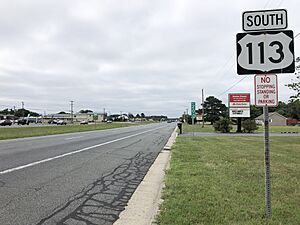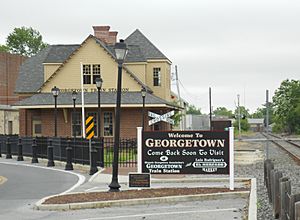Georgetown, Delaware facts for kids
Quick facts for kids
Georgetown, Delaware
|
|
|---|---|
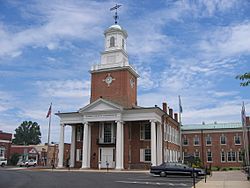
Sussex County Courthouse and the Circle
|
|
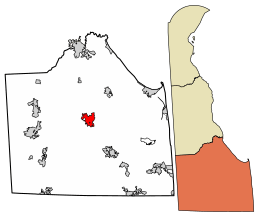
Location of Georgetown in Sussex County, Delaware.
|
|
| Country | United States |
| State | Delaware |
| County | Sussex |
| Founded | 1791 |
| Area | |
| • Total | 5.02 sq mi (13.01 km2) |
| • Land | 5.02 sq mi (13.01 km2) |
| • Water | 0.00 sq mi (0.00 km2) |
| Elevation | 52 ft (16 m) |
| Population
(2020)
|
|
| • Total | 7,134 |
| • Density | 1,420.55/sq mi (548.50/km2) |
| Time zone | UTC−5 (Eastern (EST)) |
| • Summer (DST) | UTC−4 (EDT) |
| ZIP Code |
19947
|
| Area code(s) | 302 |
| FIPS code | 10-29090 |
| GNIS feature ID | 213993 |
| Website | www.georgetowndel.com |
Georgetown is a town in Delaware, United States. It is the main town, or county seat, for Sussex County, Delaware. In 2020, about 7,134 people lived there. Georgetown is part of the larger Salisbury, Maryland-Delaware area.
Contents
A Look Back at Georgetown's History
Why Georgetown Became the County Seat
Lewes, located on the Delaware Bay, was the first county seat for Sussex County. It was the first European settlement in Delaware, started by the Dutch in 1631. For a long time, it was the only important European town in the area. When William Penn organized the three southern counties of Pennsylvania (which are now Delaware), Lewes was the clear choice for the county's main legal center.
The exact borders of Sussex County were not fully decided until after 1760. This was because of a disagreement between William Penn's family and Frederick Calvert, 6th Baron Baltimore. The argument over borders made it hard to pick a good spot for the county seat. Eventually, the Mason–Dixon line was drawn to settle this dispute. This line now marks the western and southern edges of the county. Because Georgetown is more in the middle of the county, it was later chosen as the new county seat.
How Georgetown Was Founded
Lewes remained the county seat for much of the 1700s. However, it was hard for people living in the western part of the county to get there. Roads were bad, and it could take more than a day to travel to Lewes for county business.
Because of this, citizens from the west asked the Delaware General Assembly to move the county seat. On January 29, 1791, a law was passed to create a more central location. At that time, the middle of Sussex County was mostly swampy and empty. The county government hired ten people to buy land, build a courthouse and jail, and sell land lots. This was done to help a new town grow.
On May 9, 1791, these people, led by Delaware State Senator George Mitchell, bought about 76 acres for the new town. One of the commissioners, Rhodes Shankland, started by planning a large square, 100 yards on each side. Eventually, Georgetown was designed as a circle, one mile across, with this original square at its center. This circular area is now a historic district. The new location was much better for running county affairs. People still say Georgetown is "sixteen miles from everywhere" in Sussex County.
The County Courthouse and Jail were built in the southeastern part of the town circle. The county's legal center officially moved there on October 26, 1791. The new town was named Georgetown to honor George Mitchell, who led the commissioners. Land lots were sold to help the state get back its investment.
Georgetown's Later Years
During the American Civil War, Delaware was a "border state." This meant that people from Georgetown fought on both sides. Some joined the Union army, while others fought for the Confederates. The town and even some families were divided by these different loyalties.
In 2007, a monument honoring Sussex County Confederates was put up at the Marvel Museum in Georgetown. As of 2022, the town council still helps fund this museum.
Culture and Community Life
Since the mid-1900s, two main activities have shaped Georgetown: the Sussex County Courts and raising chickens. Many chickens are grown on local farms and then processed at large plants like Purdue Farms in Georgetown. This industry has brought many new people to the town, especially immigrants from Haiti and Guatemala. This has made Georgetown's population very diverse.
Many residents speak Haitian French or Creole, and many more speak Spanish as their first language. This is in addition to those who speak English. In 2000, over one-third of the people were Hispanic, and one-fifth were African American (including Haitians).
Georgetown is also home to WZBH radio and the Georgetown Speedway. The Speedway brings many visitors from far away during race season.
What is Return Day?
Every two years, Georgetown hosts a special event called Return Day. It's a parade and festival held two days after Election Day. This tradition comes from old times when people would gather in Georgetown to hear election results. It took two days for the results to arrive by horseback from the state capital.
On Return Day, the winners of the recent elections ride in horse-drawn carriages around The Circle. They, along with the people who lost and the leaders of the county's political parties, take part in a ceremony. They "bury the hatchet" in a tub of sand, which means they put their disagreements aside. The afternoon of Return Day is a holiday for county and state workers in Sussex County. The day also includes a traditional ox feast and marks the start of new political campaigns.
Georgetown's Unique Architecture
Georgetown is special among Delaware towns because it was built around a large circle, not a typical square park. At "The Circle" you'll find the Town Hall, state and county buildings, and the historic Sussex County Courthouse. The current courthouse was built in 1837 and was restored in 1976. It is now managed by the Georgetown Historical Society.
Lawyers' offices, newer court buildings, a bank, and the Brick Hotel (now offices) also line the Circle. This layout is similar to the one found in Annapolis, Maryland. The very center of Georgetown's circle is a small green park with a fountain.
Georgetown's oldest church is St. Paul's Episcopal Church. It was built in 1844 and updated in 1881 in the early Victorian Gothic style. Its church group started in 1794, soon after the American Revolutionary War. This church is listed on the National Register of Historic Places.
Many other historic buildings and places in Georgetown are also recognized. These include the Joseph T. Adams House, Brick Hotel, Peter S. Faucett House, and the Old Sussex County Courthouse.
Where is Georgetown Located?
Georgetown is located at 38°41′24″N 75°23′08″W / 38.69000°N 75.38556°W. The town covers about 4.1 square miles (10.6 square kilometers) of land.
What is Georgetown's Climate Like?
| Climate data for Georgetown, Delaware (Delaware Coastal Airport), 1991–2020 normals, extremes 1945–present | |||||||||||||
|---|---|---|---|---|---|---|---|---|---|---|---|---|---|
| Month | Jan | Feb | Mar | Apr | May | Jun | Jul | Aug | Sep | Oct | Nov | Dec | Year |
| Record high °F (°C) | 77 (25) |
77 (25) |
88 (31) |
94 (34) |
98 (37) |
101 (38) |
104 (40) |
100 (38) |
98 (37) |
96 (36) |
86 (30) |
77 (25) |
104 (40) |
| Mean maximum °F (°C) | 67.6 (19.8) |
67.8 (19.9) |
76.4 (24.7) |
84.6 (29.2) |
90.3 (32.4) |
94.4 (34.7) |
97.3 (36.3) |
94.2 (34.6) |
90.9 (32.7) |
84.3 (29.1) |
75.6 (24.2) |
68.9 (20.5) |
98.0 (36.7) |
| Mean daily maximum °F (°C) | 45.2 (7.3) |
47.8 (8.8) |
55.2 (12.9) |
66.3 (19.1) |
74.5 (23.6) |
83.1 (28.4) |
87.7 (30.9) |
85.7 (29.8) |
79.5 (26.4) |
69.3 (20.7) |
58.7 (14.8) |
49.9 (9.9) |
66.9 (19.4) |
| Daily mean °F (°C) | 36.9 (2.7) |
38.9 (3.8) |
45.8 (7.7) |
55.8 (13.2) |
64.5 (18.1) |
73.6 (23.1) |
78.6 (25.9) |
76.7 (24.8) |
70.3 (21.3) |
59.3 (15.2) |
49.2 (9.6) |
41.3 (5.2) |
57.6 (14.2) |
| Mean daily minimum °F (°C) | 28.6 (−1.9) |
30.0 (−1.1) |
36.3 (2.4) |
45.3 (7.4) |
54.5 (12.5) |
64.0 (17.8) |
69.5 (20.8) |
67.7 (19.8) |
61.2 (16.2) |
49.4 (9.7) |
39.6 (4.2) |
32.7 (0.4) |
48.2 (9.0) |
| Mean minimum °F (°C) | 9.1 (−12.7) |
12.9 (−10.6) |
19.9 (−6.7) |
29.9 (−1.2) |
39.0 (3.9) |
49.0 (9.4) |
57.7 (14.3) |
55.8 (13.2) |
46.3 (7.9) |
32.8 (0.4) |
23.8 (−4.6) |
17.0 (−8.3) |
6.6 (−14.1) |
| Record low °F (°C) | −13 (−25) |
−8 (−22) |
3 (−16) |
20 (−7) |
26 (−3) |
35 (2) |
43 (6) |
42 (6) |
32 (0) |
21 (−6) |
14 (−10) |
−7 (−22) |
−13 (−25) |
| Average precipitation inches (mm) | 3.01 (76) |
2.58 (66) |
3.86 (98) |
3.29 (84) |
3.63 (92) |
4.07 (103) |
4.14 (105) |
3.99 (101) |
4.54 (115) |
4.11 (104) |
3.19 (81) |
3.47 (88) |
43.88 (1,115) |
| Average precipitation days (≥ 0.01 in) | 9.4 | 10.0 | 11.3 | 11.1 | 11.8 | 13.1 | 11.2 | 11.8 | 12.0 | 11.3 | 9.1 | 10.1 | 132.2 |
| Source: NOAA | |||||||||||||
Who Lives in Georgetown?
| Historical population | |||
|---|---|---|---|
| Census | Pop. | %± | |
| 1850 | 777 | — | |
| 1860 | 553 | −28.8% | |
| 1870 | 710 | 28.4% | |
| 1880 | 895 | 26.1% | |
| 1890 | 1,353 | 51.2% | |
| 1900 | 1,658 | 22.5% | |
| 1910 | 1,609 | −3.0% | |
| 1920 | 1,710 | 6.3% | |
| 1930 | 1,763 | 3.1% | |
| 1940 | 1,820 | 3.2% | |
| 1950 | 1,923 | 5.7% | |
| 1960 | 1,765 | −8.2% | |
| 1970 | 1,844 | 4.5% | |
| 1980 | 1,710 | −7.3% | |
| 1990 | 3,732 | 118.2% | |
| 2000 | 4,643 | 24.4% | |
| 2010 | 6,422 | 38.3% | |
| 2020 | 7,134 | 11.1% | |
| U.S. Decennial Census | |||
In 2000, there were 4,643 people living in Georgetown. About 56% of the people were White, and about 21% were African American. About 18% were from other races, and 2.5% were from two or more races. A large part of the population, about 31.7%, identified as Hispanic or Latino.
About 25% of the people were under 18 years old. The average age in Georgetown was 30 years. For every 100 females, there were about 107 males.
In 2000, 21.6% of Georgetown residents said they were of Guatemalan heritage. This was the highest percentage of Guatemalan Americans in any place in the United States at that time.
Getting Around Georgetown
Roads and Highways
The main north-south road in Georgetown is US 113. It goes through the western part of town. This road connects Georgetown to towns like Millsboro to the south and Milford to the north.
US 9 runs southwest-northeast through Georgetown. It connects to Laurel to the southwest and Lewes to the northeast. From Lewes, you can take the Cape May–Lewes Ferry across the Delaware Bay.
Other important roads include DE 18 and DE 404. These routes help connect Georgetown to other parts of Delaware and even to the Baltimore-Washington Metropolitan Area. There are also special truck routes, US 9 Truck and DE 404 Truck, to help trucks avoid the town center.
Airports and Public Transport
The Delaware Coastal Airport is just east of Georgetown. It's used for general aviation, like private planes. For commercial flights, the closest airport is the Wicomico Regional Airport in Salisbury, Maryland.
DART First State provides bus service in Georgetown. These buses connect the town to places like Lewes, Bridgeville, and Dover. DART First State also has a special service called DART Connect for the Georgetown and Millsboro areas.
In the past, passenger trains used to run through Georgetown until the late 1940s. Today, the Delmarva Central Railroad operates freight trains on these lines.
Town Services
Delmarva Power provides electricity to Georgetown homes and businesses. Chesapeake Utilities supplies natural gas. The Town of Georgetown Water Department makes sure everyone has clean water. The Wastewater Department handles sewage. Trash and recycling are collected by Waste Industries.
In 2013, the Bruce A. Henry Solar Farm near Georgetown started producing electricity from the sun. It was made even bigger in 2020.
Education Opportunities
- The Jack F. Owens campus of Delaware Technical Community College is located in Georgetown.
- Georgetown is part of the Indian River School District.
- Sussex Central High School is located in Georgetown.
Famous People from Georgetown
- Wilbur L. Adams, a lawyer and U.S. Representative from Delaware.
- Matt Barlow, a former singer for the band Iced Earth, who now works as a police officer in Georgetown.
- Robert H. Pepper, a lieutenant general in the US Marine Corps during World War II.
- Luke Petitgout, an NFL football player for the New York Giants and Tampa Bay Buccaneers.
- Bryan Stevenson, a civil rights attorney.
- Charles C. Stockley, the 45th Governor of Delaware, was born in Georgetown.
- George Alfred Townsend, a journalist and writer.
- Caleb Merrill Wright, a judge and lawyer.
See also
 In Spanish: Georgetown (Delaware) para niños
In Spanish: Georgetown (Delaware) para niños




